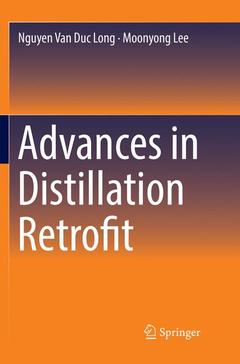Description
Advances in Distillation Retrofit, Softcover reprint of the original 1st ed. 2017
Authors: Long Nguyen Van Duc, Lee Moonyong
Language: English
Subjects for Advances in Distillation Retrofit:
Keywords
Dividing Wall Column; Extractive Distillation; Feed Thermal Condition Changing; Inter-reboiling; Operating Pressure Changing; Petlyuk Column; Prefractionator Arrangement; Pressure Swing Azeotropic Distillation; Process Integration; Process Intensification Techniques; Process Intensification Technology; Retrofit of Distillation Processes; Self-heat Recuperation; Side Heat Exchanger; Thermally Coupled Distillation Sequence
Approximative price 105.49 €
In Print (Delivery period: 15 days).
Add to cartPublication date: 12-2018
Support: Print on demand
Approximative price 105.49 €
In Print (Delivery period: 15 days).
Add to cartPublication date: 10-2017
Support: Print on demand
Description
/li>Contents
/li>Biography
/li>Comment
/li>
This book describes the current state of the art in the retrofit of existing distillation processes using advanced distillation techniques. Highlighting concept and practical application rather than theory, it emphasizes the use of advanced process integration and intensification techniques, such as multi-effect distillation, heat pump assisted distillation, thermally coupled distillation, dividing wall column, reactive distillation, and innovative hybrid systems.
As a thermal separation method, distillation is one of the most important and widely used technologies in the chemical process industry. While it has many advantages, one major drawback is its large energy requirement, which can significantly influence overall plant profitability. The increasing cost of energy has forced industry to reduce its energy requirement, but simultaneously there has been a need to increase capacity and output due to heightened demand. To accomplish this, the retrofit of distillation processes to increase efficiency and output has become a crucial issue. This book describes the use of advanced process integration and process intensification techniques to carry out effective distillation retrofit.
Written by leading researchers in distillation process, process integration, process intensification, and process retrofit, the book presents a comprehensive review of contemporary advanced distillation techniques which can be employed in grass-root systems and retrofit. It is a valuable source of information for undergraduate and postgraduate students of chemical engineering, practicing process designers and chemical engineers.
1 Introduction. 1.1. Introduction. 1.2. Distillation fundamentals and principles. 1.3. Distillation design. 1.4. Distillation simulation. 1.5. Distillation retrofit and debottlenecking. 1.6. Concluding remarks. References.
2 Column internal. 2.1. Introduction. 2.2. Types of column internal. 2.3. Retrofit and debottlenecking by modifying column internal. 2.4. Case study. 2.5. Concluding remarks. References.
3 Promising retrofit technologies for single column. 3.1. Introduction. 3.2. Heat pump assisted distillation. 3.3. Self-heat recuperation technology. 3.4. Feed thermal condition. 3.5. Side reboiler or side condenser. 3.6. Operating pressure changing. 3.7. Multi-effect method. 3.8. Cyclic distillation. 3.9. Concluding remarks. References.
4 Promising retrofit technologies for multicolumn system. 4.1. Introduction. 4.2. Re-arranging the distillation sequence. 4.3. Prefractionator arrangement. 4.4. Thermally coupled distillation sequence. 4.5. Alternative coupled scheme of Petlyuk column. 4.6. Dividing wall column. 4.7. Dividing wall prefractionator configuration. 4.8. Multi-effect configuration. 4.9. Combination of internal and external heat integration. 4.10. Concluding remarks. References.5 Promising retrofit technologies of nonconventional distillation column. 5.1. Introduction. 5.2. Batch distillation. 5.3. Side stream column. 5.4. Pressure swing azeotropic distillation. 5.5. Extractive distillation. 5.6. Azeotropic distillation. 5.7. Reactive distillation. 5.8. Hybrid system. 5.9. Concluding remarks. References.
Appendix.
List of Abbreviations.
Nguyen Van Duc Long is currently a Foreign Assistant Professor at Yeungnam University. He received his PhD in the Department of Chemical Engineering at Yeungnam University in August, 2012. Subsequently, he joined Samsung Cheil Industries as a Senior Process Engineer. He has worked on many long-term industrial projects, which were collaborative efforts between his laboratory and industrial manufacturers or engineering companies. These industrial projects mainly focus on process systems engineering, process retrofit and debottlenecking technologies, process integration and intensification technologies, dividing wall column, thermally coupled distillation sequence, reactive distillation, extractive distillation, azeotropic distillation, pressure swing distillation, batch distillation, heat pump assisted distillation, self-heat recuperation technology, separation processes, reactive separation processes, sustainable chemical processes, exergy and energy efficiency, natural gas processing, petroleum refinery, carbon capture, storage and utilization, carbon dioxide emission reduction, gasification, biofuels and green energy, biochemicals, biomass conversion and biorefineries. He published 38 scientific articles in peer-reviewed journals, 3 review papers and 1 book chapter.
Moonyong Lee has been a professor at Yeungnam University, School of Chemical Engineering, since 1994. Before joining the university, he had worked as Senior Process Engineer in SK refinery and petrochemical company for 10 years. He has an MSc and a PhD in Chemical Engineering from KAIST. Since entering the university, he has worked on many industrial projects related to process modeling, design, and control. His current research areas are design, modeling, optimization, and control of various energy and chemical processes (especially distillation based separation processes). He is the author of over 150 publications in international journals and the recipient of the GoMyeun
Presents an up-to-date snapshot of the field, and provides an insightful review to all the key techniques used in the revolution in distillation intensification
Provides a comprehensive coverage of contemporary advanced distillation issues, such as TCDS and DWC
Bridges the gap between developers of advanced distillation design procedures and those ultimately using them




